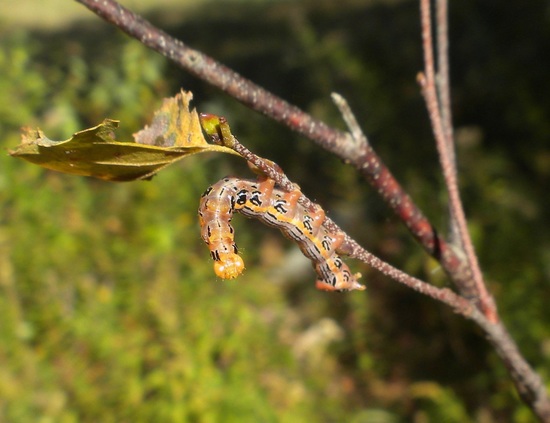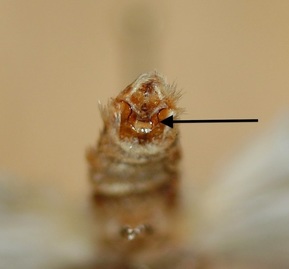This colorful caterpillar was found on Ware River watershed property in Barre on October 6th. The Symmerista family of caterpillars present identification challenges, so we pulled out our copy of David Wagner's Caterpillars of Eastern North America. The head color, something between orange and lemon-yellow, threw us off at first. But Red-humped Oakworm (Symmerista canocosta) and White-headed Prominent ( S. alibifrons)--difficult to separate in the field-- dine on beech, chestnut, and oak. This critter was chowing down on the last leaf remaining on a small birch sapling. Also, the dorsal stripe pattern is consistent with Orange-humped Mapleworm (Symmerista leucitys).
A web search brought us to the blog of DenPro, a field biologist and educator in southeastern Ohio (thanks, DenPro, whoever you are), who points out that S. leucitys can also be hard to separate from the other two Symmeristas in the field, presumably because of changes that occur at different instars (stages of growth).
A web search brought us to the blog of DenPro, a field biologist and educator in southeastern Ohio (thanks, DenPro, whoever you are), who points out that S. leucitys can also be hard to separate from the other two Symmeristas in the field, presumably because of changes that occur at different instars (stages of growth).
Obviously we didn't investigate to this level. So what about that birch food plant? On the site The Lepidoptera of Wayne County, Ohio, we found this information that states that the larval host plant(s) of S. leucitys is/are unknown. But Wagner lists maple, especially sugar maple, as the host. Maybe S. leucitys often eats birch, unnoticed. Maybe it's a new behavior. The larvae of many butterflies and caterpillars are sometimes found on new and unexpected host plants; this is a topic too large for this page. But our little mystery demonstrates the benefits and enjoyment of the close observation of the nature around us.

